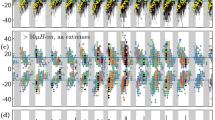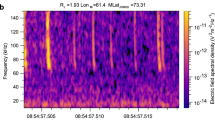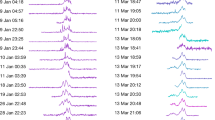Abstract
Frihagen and Tröim1 have already observed a deep and nearly sinusoidal type of fading on fast amplitude records at 108 Mc/s. The effect only lasted for a few periods and a time delay between similar features on records taken at two spaced aerials indicated that it was introduced in the ionosphere. They proposed that this phenomenon was caused by diffraction at a single ‘blob’ in the ionosphere and that it is similar to that which was observed in radio-star scintillation by Wild and Roberts2. Apparently the same kind of amplitude variations were observed on several occasions at Kiruna (67.8° N., 20.4° E.) (ref. 3) on records of Transit IV A at 54 Mc/s which showed intense scintillation. The phenomenon was usually more persistent than that observed by Frihagen and Tröim and often lasted up to a hundred periods. The fading periods varied between 50 and 500 msec, but there was a predominance of periods of about 100 msec. Fig. 1 gives an example of persistent regular fading lasting about 10 sec. Some cases of the phenomenon of short duration (about 1 sec) which exhibit monotonically increasing (or decreasing) amplitude and period may be explained by diffraction at single ‘blob’ in the ionosphere. However, it is difficult to explain long lasting, regular fading in this way.
This is a preview of subscription content, access via your institution
Access options
Subscribe to this journal
Receive 51 print issues and online access
$199.00 per year
only $3.90 per issue
Buy this article
- Purchase on Springer Link
- Instant access to full article PDF
Prices may be subject to local taxes which are calculated during checkout
Similar content being viewed by others
References
Frihagen, J., and Tröim, J., NDRE Rep. No. 38 (1961).
Wild, J. P., and Roberts, J. A., J. Atmos. Terr. Phys., 8, 55 (1956).
Liszka, L., Arkiv. Geofysik, 4, 227 (1963).
Author information
Authors and Affiliations
Rights and permissions
About this article
Cite this article
LISZKA, L. A Possible Interpretation of the Fast Regular Fading observed on Satellite Transmissions. Nature 203, 178–179 (1964). https://doi.org/10.1038/203178a0
Issue Date:
DOI: https://doi.org/10.1038/203178a0
Comments
By submitting a comment you agree to abide by our Terms and Community Guidelines. If you find something abusive or that does not comply with our terms or guidelines please flag it as inappropriate.



